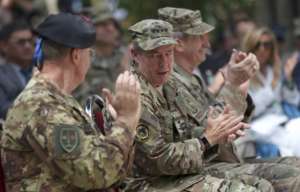
Army general: ‘Time for this war to end’
US strategy in its longest war is shifting. So how come no one in Congress is talking about it?

Over Labor Day weekend, a change in command occurred. I almost said a “routine” change but in a war zone, little is routine. U.S. and NATO forces in Afghanistan now have a new commander, Army Gen. Austin Miller.
Miller is the 17th person to hold the position, replacing the retiring Gen. John Nicholson. Commands change more quickly in the modern Army. From 1964 to 1972 only two generals led U.S. forces in Vietnam.
Nicholson had the longest command tour in Afghanistan at 31 months. His experience led him to say, remarkably, “It’s time for this war in Afghanistan to end.” To the Taliban, he said “you don’t need to keep killing your fellow Afghans. You don’t need to keep killing your fellow Muslims.”
Reading the dry account on the Defense Department’s own news site, I could hear both frustration and resolve.
Some historians might see an irony there: The Taliban originated out of the same Mujahedeen the U.S. had supported as proxies against the Soviet Union in the 1980s. Regardless, no evidence suggests they will give up on their quest to control Afghanistan any more than than the Vietcong were persuaded by a half-million American troops and incessant bombing.
The 17-year-old U.S. war in Afghanistan started, in a sense, a few weeks after the Sept. 11, 2001, attacks by al-Qaida. But the U.S. had indicted Osama bin Laden back in 1998. In 1999 the U.S. demanded the Taliban surrender him.
It’s a long, complicated tale of U.S. involvement with a country that has been at war with itself since the 1970s. Just last month, the Taliban rebuffed a call from Afghan President Ashraf Ghani for a cease fire during the Muslim holiday of Eid al-Adha.
Price tag now in the trillions
U.S. military action there has also been expensive. In his departure remarks, Nicholson recited the names of the first and last troops killed under his watch, the New York Times reported. U.S. deaths in Afghanistan are approaching 2,400, with more than 20,000 wounded.
Thus the frustration Nicholson expressed. No general I’ve ever met relishes the prospect of endless war, and no one favors the steady-burning stasis now in place.
So what is the goal? Two possible extremes come to mind. One, kill every member of the Taliban. But that’s not in the cards for a variety of reasons. Another option, just pull out and let them take over, but that would betray both U.S. strategic goals and negate the investment.
Nicholson said U.S. and allied forces will stay as long as necessary to thwart the Taliban. The policy of the Trump administration seems to encourage negotiations while promising to keep fighting. Its “South Asia strategy” seeks to wreck the local terrorist groups but not signal a deadline after which the U.S. will leave. The strategy also seeks to shift American resources more towards training and support and less combat.
This may not be the Hundred Years’ War, but the length of the Afghanistan involvement has obtained a sort of grandeur. A 19-year-old soldier there today can’t remember the 9/11 attacks directly.
Whatever the answer, it will require bipartisan political leadership, if that’s even possible today. It means that while the U.S. can’t accept a terror-breeding caliphate, neither can it expect Afghanistan to come out like Sweden. In his departing remarks, Nicholson said he believes some Taliban members also want peace and would reconcile with a broader Afghan government. Maybe that’s the straw to tug on? Defense Secretary James Mattis has made similar statements. One problem is how do such Taliban members stay alive?
Meanwhile, administrations propose and Congress appropriates tens of billions of dollars annually. Have you heard much debate about it lately? Me neither.
Miller, the new commander, first deployed to Afghanistan in 2001 and was there again as a special operations commander. Now he’ll likely retire from there, and won’t be the last.
Copyright © 2025 Federal News Network. All rights reserved. This website is not intended for users located within the European Economic Area.
Tom Temin is host of the Federal Drive and has been providing insight on federal technology and management issues for more than 30 years.
Follow @tteminWFED




